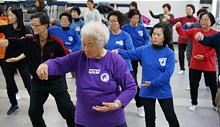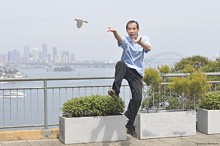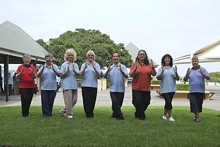How to Adapt the TCA Program for Fall Prevention
Discussion:
Older people are more likely to fall, resulting in serious injury. Many measures can help to reduce the risks of falls, and studies have shown tai chi is one of the most effective. In fact, a number of research studies, using Dr Lam’s Tai Chi for Arthritis program, indicate a significant reduction in recurrent falls. The Centers of Disease Control and Prevention (cdc.gov) recommend Tai Chi for Arthritis as a safe intervention for fall prevention, as well as Accident Compensation Corporation (ACC), a New Zealand National Governmental body, and health departments in Australia.
As a result, Dr Lam and his colleagues have developed the following guidelines for Tai Chi for Arthritis instructors to place more emphasis on fall prevention. It does not in any way change the program, it is just another method to enhance the same program.
The key to using Tai Chi for Arthritis effectively for falls prevention is to follow tai chi principles. These essential principles are divided into three categories: Movement control, body and internal aspects. They were taught as an integral part of learning the Tai Chi for Arthritis program. These principles are closely related to scientific evidence that support how they work.
After your students become familiar with the Tai Chi for Arthritis program while working on incorporating these principles over time, they will acquire an effective evidenced based program to reduce their risk of falls, as well as an effective program for health and wellbeing.
It is useful to use different perspectives to enhance the understanding of the tai chi principles. Consider using mindfulness as another way to work on the principles. The more you incorporate tai chi principles, the less likely you are to fall.
Be mindful of:
1. BREATHING
Freeing up the breathing can help improve relaxation and lower the risk of falling. Incorporating the dan tien breathing method (described below) is one good way to free up breathing. Better breathing relaxes people and improves confidence, thereby reducing the risk of falling.
Emotional states have a direct impact on your breathing pattern. If you breathe slowly and deeply for a few moments, you start to relax, tension leaves your body, and you begin to feel at ease. When people become very distressed, deep breaths can help them to calm down.
Stress tends to increase our breathing rate. Increased breathing leads to taking in too much oxygen and releasing too much carbon dioxide. Since carbon dioxide is acidic, the pH levels of the blood decrease, disturbing our body chemistry. This can cause the blood vessels to tighten, which increases blood pressure. Prolonged high blood pressure has a significant effect on our health.
However, mindful breathing leads to a relaxation response within our body and mind. We literally can, ‘breathe easy’ as our blood chemistry and blood pressure return to normal levels.
The dan tien breathing method
This breathing method enhances qi and promotes relaxation. Visualise as you breathe that the air travels through your nose, down your trachea (airway to the lungs), filling the lungs and then the abdomen. Your abdomen is filling up with air, making it bulge gently outwards. As you breathe out, the abdomen gently contracts. Visualise the air expelling from the abdomen, lungs, trachea and finally through your nose. (Physically, air doesn’t enter the abdomen. This is a method using guided imagery to help utilize your diaphragm to open up more air space in your lungs.). When doing this, focus at keeping the upper part of your abdomen as still as possible and only move the lower abdomen with breathing gently. Relax your lower abdominal muscles as you breathe in, and gently contract them, along with the pelvic floor muscles, as you breathe out. Practice this as often as you can. You can use this breathing method almost anywhere.
2. WEIGHT TRANSFERENCE
Being mindful of your weight transference improves balance, thus reducing the risk of falling. Correct weight transference depends on good dynamic and static postures. An upright and supple posture enhances mental alertness and strengthens the inner structures like the deep stabiliser muscles.
Be mindful of weight transference starting from posture awareness. As you move in any direction, put your weight on one leg, while maintaining an upright posture. Be aware of bending knees, touching down gently with the heel, and gradually placing the entire foot on the ground and then, slowly and mindfully transferring your weight forward.
Teach the student to stand upright but relaxed; to look straight ahead, tuck in chin, and make sure shoulders, elbows, and knees are relaxed. Imagine the body as a string that is being stretched gently from both ends. Maintain posture awareness with stepping forward, backward and then sideways being mindful of weight transference.
3. SITUATION
Being mindful of where and what situation you are in at the moment makes you mentally more alert. Be aware of what situation you are in and focus on what you are doing – walk with focus and be aware of where your body is, and how weight is shifted.
Encourage your students to apply being mindful of these three points at any time when sitting, working or doing tai chi.
Practice
Practice the Basic Six integrating these 3 points. Form 1 and 2, are ideal for focusing at breathing; Form 3 for weight transference and 4 for situation awareness.
Incorporating Tai Chi into real life situations
Some of the known circumstances of increased risk of falls for elderly are:
- getting out of bed in the middle of the night, or early in the morning
- pegging washing on the line
- walking on uneven ground
- when visibility is poor (refer to health professionals)
- when feeling less confident (eg, better posture and free breathing improve confidence and relax the tensed muscles which leads to better balance).
- when wearing multi-focal glasses
- in association with other illness
- in association with some medications (refer to health professionals)
Teaching participants to use awareness of breath, posture and weight transference, and situational awareness during the above situations could help to reduce the rate of falling.
Teach participants to incorporate mindfulness into their tai chi practice and to apply it whenever possible. For instance, when waiting for the kettle to boil, try flexing the ankles or bend knees slightly and think of upright posture. Practise tai chi walking back and forth mindful of weight transference across the kitchen while cooking. When working at the bench, visualise wave hands like clouds and turn economically to reach objects from the left or right. Train themselves to think of the situation (where they are and what they are doing). For example, be aware of not over-reaching which may cause a fall.
When turning or stepping back and forth to appliances in smaller spaces such as the laundry, be aware of the transfer of weight from one foot to the other, to avoid twisting a knee or ankle. When vacuuming or cleaning windows, move the body from the waist, not just the arms. Many tai chi students report that housework becomes easier this way. When watching TV, use the advertisement breaks to perform the warm up or Basic Six forms.
Tai chi practiced with the six essential principles and mindfulness of breath, weight transference, and situational awareness can easily be translated into many aspects of daily life with the results of a more stress-free life and the possibility of fewer falls.




